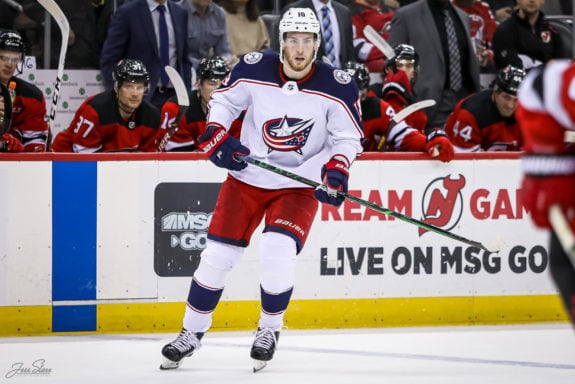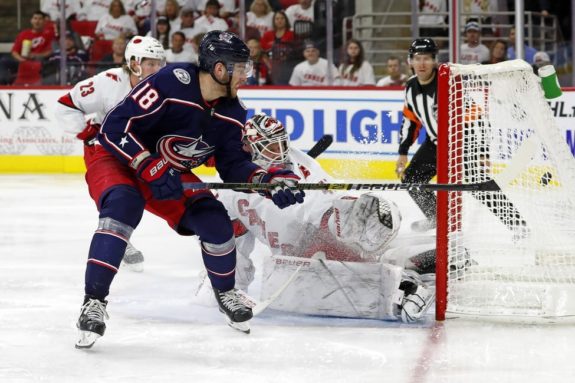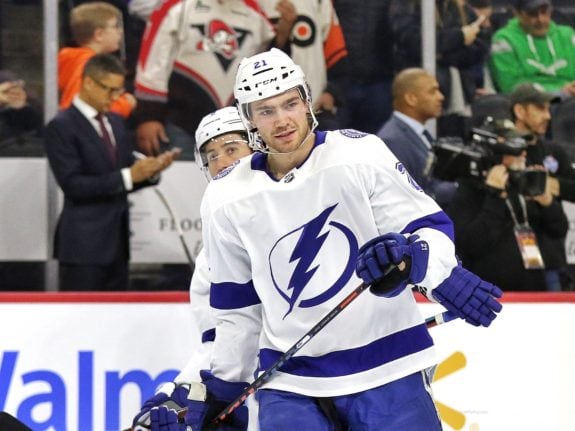
 Brian Ginise
The Hockey Writers
Brian Ginise
The Hockey Writers
35
Reads
0
Comments
Blue Jackets’ RFA Pierre-Luc Dubois Dominates In Playoff Run
The Columbus Blue Jackets had an impressive playoff showing in 2020, despite technically bowing out in the first round. They dispatched an offensively loaded Toronto Maple Leafs team in the play-ins and forced the best out of the Stanley Cup favorite Tampa Bay Lightning in their five-game series before ultimately losing out. They were carried by otherworldy goaltending from Joonas Korpisalo, but one of the other drivers of success for the team was Pierre-Luc Dubois.

Dubois’ 2020 playoff performance was a step in the right direction for the young center. Still only 22, he seemed to emerge from Artemi Panarin’s shadow in his third playoffs and attracted plenty of attention on a national stage – both good and not so good.
Related: What If? The Islanders, the Blue Jackets, Ryan Murray & the 2012 Draft
For this article, though, we’re only going to focus on the good, which was his impressive play throughout both series. At times we saw him take over portions of the game with his physicality and puck protection, and he looked faster than he has in previous postseasons. Just how good was he, though, and what more could he possibly give in the future? Plus, he’s up for a contract extension this summer, so what does his recent performance mean for Columbus’ finances?
How Good Was He?
In 10 playoff games this season, Dubois had 4 goals and 6 assists for 10 points, averaging nearly 23 minutes of ice time per night. Those are bonafide top-line center numbers, and he didn’t do it with Panarin controlling most of the play from his wing. His performance was impressive analytically as well. I will briefly explain what each metric means as I cover it, but for further analysis feel free to visit Evolving-Hockey’s glossary page.
Against Toronto, his three goals were first on the CBJ, and his four points were second behind only Cam Atkinson. He was first in iHDCF (individual High Danger Chances For) with nine, first in ixG (individual Expected Goals) with 1.92, first in rebounds created, first in iSCF (individual Scoring Chances For) with 17… noticing a pattern? For the most part, he led the Jackets in almost every important offensive category analytically, and when he didn’t he was almost always in the top three, per Natural Stat Trick.
Against Tampa, it was more of the same. One goal and five assists for six points, which led the team, and all five assists were primary. He was first in ixG (1.54), iSCF (17) and rebounds created. But there was something else in this series, too. He was third in xGF behind Zach Werenski and Seth Jones, and second in xGF% (Expected Goals For Percentage).
In fact, percentage-wise, Dubois’ control of the puck was outstanding – more so than in the play-in round. This suggests that defensively he was more effective against Tampa than he was against Toronto, which is no small feat considering Tampa led the league with 243 goals in 70 games this year. He had an absurd 66.67 GF% (Goals For percentage) and his 60.4% SCF% (Scoring Chances For percent) was fourth-best. To play against the Bolts and have any puck driving metric above 50% is elite, so 60% or more is incredible.
But how did he compare to other NHL players that aren’t Columbus Blue Jackets? His 1.92 ixG was second-best in the play-in series behind only John Tavares, and his three goals were third overall league-wide in the play-in round, behind only Jonathan Toews and Connor McDavid, who played in a defense-less series. In fact, Dubois’ 10 points rank tied for 10th overall right now, despite the fact that he hasn’t played in almost a week.
His 1.54 ixG and 17 iSCF were both second-most of any skater in the Tampa series, behind only Brayden Point. His six points also were tied for the series lead with Point and Kucherov, who are *double-checking* pretty good players, sources say.
Dubois’ 1.42 average GameScore over his playoff ranks 22nd overall in the league, tied with Mathew Barzal, just behind Gabe Landeskog and Elias Pettersson. In his hat trick game against Toronto, Dubois earned a 3.72 GameScore, the third-best skater the entire night analytically. Clearly he was at his best for much of these playoffs, and his best is among the elite in the league.
So where else can Dubois improve? Well, the obvious answer is consistency, a sentiment head coach John Tortorella echoed. When asked if Dubois took his next step in these playoffs as ‘an impact guy’, he said “At times. Still needs to be more consistent.” That might seem like the typical Tortorella answer, but it’s true. While Dubois’ highest GameScore performance was an impressive 3.72, his lowest was a measly -.68, in the game where Tortorella absolutely ripped him on the bench on live TV.
It’s not awful, but it also isn’t good enough when the competition at center ice for you is John Tavares and Auston Matthews. His four goals in the 10 playoff games are also impressive at face value, but less so when you take into account three of them came in one game. Dubois isn’t a big-time sniper and isn’t surrounded by a plethora of offensive talent, nor does he play in an open, offensive system, but you can’t deny the inconsistencies.

We also saw it on the ice. When Dubois was going, he was an absolute horse. He could pin the puck in the offensive zone with his speed on the forecheck and elite puck protection. He looked relatively similar to the Blue Jacket version of Ryan Johansen, who used to control the puck at will on the half-board on the power play.
Related: Revisiting the Artemi Panarin Trade
His teammates see it, too. When asked about him after the hat-trick game, Cam Atkinson said “I just think with Luc, if he wants to be a difference-maker, a game-changer, one of the best players I think in the league, he has all the capabilities, all the tools”. When he can put it all together, and it seems like he is doing it increasingly often, he can be a difference-maker on a Columbus team in desperate need of them.
What It Means Going Forward
Dubois, who is a restricted free agent (RFA) this offseason, should benefit from his impressive playoffs. But how much, and what kind of contract will he be searching for? Well, his agent Pat Brisson won’t be taking the NHL’s projected flat cap into account, I can assure you of that. Evolving-Wild’s contract projection has his most likely deal coming in at seven years at $7.1 million per. While I think that makes sense for Columbus, and they’d be thrilled to have him locked in for seven years, I think a bridge deal is the more likely route.
We need to look at some comparables to try to get a better idea. Tampa’s Brayden Point and the San Jose Sharks’ Timo Meier make a lot of sense. You could make the argument that both are a little ahead of Dubois at this stage in their careers, particularly Point, but the value is similar enough. Meier got a four-year deal in San Jose worth $6 million per as a 22-year old (7.36% cap hit), and Point took a three-year bridge at $6.75 million as a 23-year old (8.28% cap hit).

General manager Jarmo Kekalainen, assistant GM Bill Zito and the Blue Jackets are notoriously harsh negotiators, particularly for RFAs without arbitration rights, but I think a three- or four-year bridge makes the most sense for both sides here despite likely efforts from Dubois to go long-term. This way, you get a clearer picture of where his ceiling and subsequent value is, and Dubois can really cash in in a few years when the cap increases again.
It will be interesting to see what happens this offseason in Columbus – THW’s own Mark Scheig has some ideas. I think Jarmo will try to make a splash to get more help offensively, and that could bump Dubois’ numbers up further. Regardless, it seems the Jackets have a bonafide No. 1 center on the team, and with his improvement showing no signs of slowing down, he could be the cornerstone up front Columbus needs to build around.
The post Blue Jackets’ RFA Pierre-Luc Dubois Dominates In Playoff Run appeared first on The Hockey Writers.
Popular Articles

















































 Blackhawks Chicago
Blackhawks Chicago Panthers Florida
Panthers Florida Penguins Pittsburgh
Penguins Pittsburgh Rangers New York
Rangers New York Avalanche Colorado
Avalanche Colorado Kings Los Angeles
Kings Los Angeles Maple Leafs Toronto
Maple Leafs Toronto Bruins Boston
Bruins Boston Capitals Washington
Capitals Washington Flames Calgary
Flames Calgary Oilers Edmonton
Oilers Edmonton Golden Knights Vegas
Golden Knights Vegas Senators Ottawa
Senators Ottawa Lightning Tampa Bay
Lightning Tampa Bay Flyers Philadelphia
Flyers Philadelphia Islanders New York
Islanders New York Sabres Buffalo
Sabres Buffalo Red Wings Detroit
Red Wings Detroit Devils New Jersey
Devils New Jersey Hurricanes Carolina
Hurricanes Carolina Blue Jackets Columbus
Blue Jackets Columbus Predators Nashville
Predators Nashville Stars Dallas
Stars Dallas Jets Winnipeg
Jets Winnipeg Wild Minnesota
Wild Minnesota Blues St. Louis
Blues St. Louis Mammoth Utah
Mammoth Utah Sharks San Jose
Sharks San Jose Ducks Anaheim
Ducks Anaheim Canucks Vancouver
Canucks Vancouver






